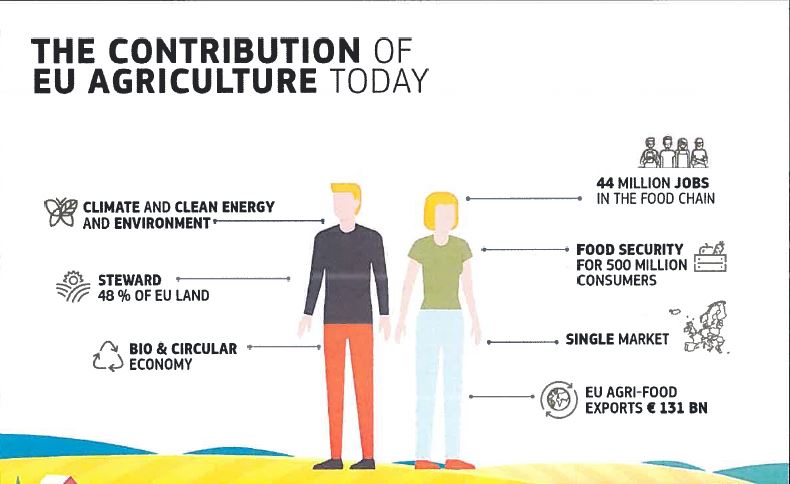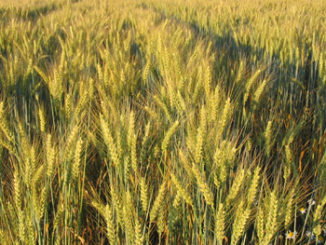UPDATED 22.05 29/11/2017 CET
Below at the link provided we present the final CAP communication. Below this we present our analysis of this Communication. There is a lack of ambition, a worrying move towards reliance on the financial sector, a lack of focus on rural areas or on some major issues. However, the results based initiative – which risking re-nationalisaiton to an extent – is at least novel and thought provoking. It potentially involves give and take by Member States with justifications accompanying subsidiarity.

Read the CAP Communication in full : future_of_food_and_farming_communication_en
ARC2020 Analysis
Farming over Food
The European Commission presents its Communication on the future of a Common Agriculture Policy. Having asked the general public and stakeholders a year ago about their vision of future food and farming policy the message is weak and disappointing. It is a very defensive blueprint to justify mainly business as usual. The core of the communication remains within a logic of subsidies based on land ownership, not on urgent challenges farming and food systems have to meet.
Although the communication is aware of societal challenges of citizens expectations and not only consumers ones, as in the previous draft – it is still far away from a sustainable farming and food systems perspective.
Direct payments still remain the cornerstone of the Commission’s reflections. Rural development appears marginalised and left to member states’ (MS) preferences – indeed the increase in subsidiarity – devolving ever more to MS – represents yet more of a de-commoning of the CAP. One would wonder how can the future CAP be, as it claims to be – smart, modern and sustainable – with such old school characteristics?
Rural areas left behind
What is very worrying is that it appears no lesson has been drawn from the fact that rural populations are frustrated about CAP and rural policies, leaving small farmers and entire rural regions behind and not delivering on the burning challenges. Moreover, no lesson has been drawn from the Cork conference a year ago where recommendations were made to invest into participative rural innovation. Very worrying also is the fact that diversification and stabilisation of rural incomes is undermined by redefining “professional farmers” as single income enterprises which ignores the reality of most EU rural regions.
Lack of understanding of the global context
Challenges are well exposed: “Climate change and national resource constraints will drive food security challenges.” However there is no reference to global food insecurity and geopolitical challenges for future CAP, except marginal remarks on migration within rural development instruments (CLLD).
Climate change, while referenced as important, is but a challenge. In other words, the CAP’s main purpose is to enable the supply of resources and products for industry and energy while coping with – but not in any real sense mitigating – climate change. This is a two fold functional and utilitarian approach to trade and migration without strategic vision. Food security too is not referenced as a threat.
In the paper the CAP is perceived as a “resilience” instrument to achieve income support and environmental and climate EU objectives. There is an emphasis on strategic plans for both Pillars, which would be results-based and would enable MS to make their own interpretation of this. However, the communication recognises that the greening CAP from 2013 has not delivered for biodiversity, while also being too burdensome.
(NEW) Results based approach
The only new element is a “result-based approach to CAP spending” which is in principle a good idea but which is not sufficiently elaborated in terms of proofing of results be it in the first or the second pillar – if they remain separate and within the CAP framework.
This initiative is in fact inspired by an external study conclusion built upon the 2013 CAP reform implementation analysis. It can be found here. (Indeed ARC2020’s Samuel Féret was involved in the development of this report, which was released in November of last year.)
Here’s a direct quote from the recommendations of that report, which can be seen in the thinking of this new Communication
“For the CAP after 2020, it is proposed to establish a more constraining framework on the Member States. This framework could, for example, include: (i) the obligation for Member States to design a national “Intervention Logic” integrating the combined effect of all policy measures, (ii) the obligation to set target indicators for all the components of the CAP, including for Pillar 1, and (iii) requiring Member States to conduct an impact assessment on both Pillar 1 and Pillar 2 elements of the CAP. This should allow for better and more efficient programming without adding complexity.”
From what we can gather at this juncture, the “new delivery model” would enable MS to design their own mixed mandatory and voluntary measures to deliver environmental and climate public goods. It remains very unclear and quite optimistic how the EU would ensure a common framework to guarantee consistency and effectiveness while some also alleviating its administrative management. This is a transfer of much administrative burden over to MS level, which then has to be, to an extent, processed and harmonised at EU level anyway. However, it is nevertheless an interesting extension of the Pillar two thinking into Pillar one, where MS would potentially have both more flexibility but also then more responsibility to justify their choices.
That said, the enhanced trend to subsidiarity in CAP is in fact another step towards renationalisation, which is a warning signal for all who want to see a harmonized European framework for future sustainable farming and food systems.
Market or Risk Management?
A risk management instruments perspective is mitigated by a risk prevention and resilience approach. Market management is completely out of the communication. Risk management and producers organizations are the two legs of the market policy (very unambitious) while further liberalisation of trade would allow the EU farming sector to develop agrifood exports to meet the “growing middle-class demand worldwide”.
This communication is a step forward towards a “CAP à la carte, further trade liberalisation, and continued direct payment. The main message the Commission communicates is that EU capitals may relax. There is little ambition for real and necessary innovation in this Communication.
Indeed though additional elements have been introduced from the leak on sustainability and resilience, it’s suprising to see that the paper remains very weak on how the CAP would encourage a bold transition towards agroecological food and farming systems.
All about the money
But the main message that EU capitals will hear is about money. Who pays for what is more important to MS than the CAP strategic plans or policy instruments. While the leak communication stated that “co-financing would endanger the smooth functioning of the internal market […] Therefore direct payments should continue to be financed at EU level”, the final communication is very clear that among other options “a degree of co-financing of the CAP” remains on the table. That’s a kind of future that a majority of MS will certainly oppose at the Ag Council meeting on 11 December, but it’s just the very beginning of a very extensive negotiation.
We in ARC2020 will provide further analysis of this Communication and of the important elements that are – and are not – in it. This will include financing the CAP, the tension between flexibility and increased autonomy to MS – the opportunities provided by a results based focus, risk management, the use of smart approaches to ensure public goods delivery, the future of participatory approaches to rural development such as LEADER and CLLD and of course the overall lack of ambition and focus big issues not included or under-emphasised in this Communication.





1 Trackback / Pingback
Comments are closed.